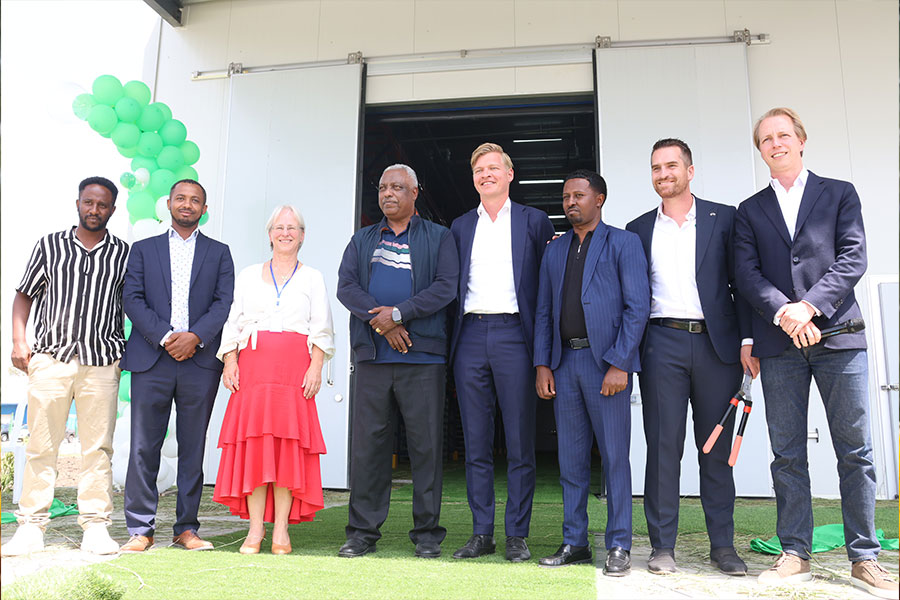
Fortune News | Mar 23,2019
A processing plant for camel milk is bracing to start production soon, after an investment of 70 million Br, almost half it obtained as a loan from the state-owned Development Bank of Ethiopia (DBE).
Khelif Milk Processing Industry (KMPI) is installing machinery and equipment at its plant in Fafen, 30Km from Jigjiga, the capital of Somali Regional State. It can process up to 16,000 litres a day though it plans to begin its production with 10,000 litres. The company plans to make half of its product available in the local market and export the remaining half to Somalia and Djibouti, neighbouring countries where demand for camel milk is high.
Camels produce milk for a more extended period in the arid and semi-arid climate, a primary source of nutrition for many pastoralists living in the region. Camel milk is widely available in high camel population weredas in Fafen zone, including Gursum, Babile, and Shebelle. It is the heart of the leading dairy shed in Somali region, which is home to 80pc of Ethiopia's camel population of 7.7 million.
Executives of the company hope to create a market for about 6,500 households.
Ethiopia produces about 4.2 million cubic metres of milk annually, out of which 80pc is cow milk, and the rest comes from camels. Four companies based in the country's eastern regions are currently erecting a plant that processes camel milk.
Berwako Milk Processing Plc was the pioneer of camel milk processing in Ethiopia, established by Amir Mukhtar in Jigjiga seven years ago. It took an investment of 18 million Br. However, it has suspended operations since last year after facing challenges stemming from the nomadic lifestyle of its milk providers, who would regularly leave the area in search of fodder for their camels.
"I was exporting camel milk to Djibouti and Somalia for seven years and the return on foreign exchange was good," said Amir.
His company used to collect camel and cow milk from approximately 300 households to process over 5,000 litres of raw milk a day.
Berwako has been shut down due to the shortage in sustainable supply and a lack of hygiene during collection. Milk handled in an unhygienic manner can easily be contaminated by pathogens like E.coli, salmonella, and listeria.
Nonetheless, if hygiene protocols are well-enforced and adhered to, the potential in the production of camel milk can be bigger, says Dawit Abate (PhD), a microbiologist who is currently working with the Bill & Melinda Gates Foundation on a study of the safety and quality of the dairy value-chain in Ethiopia.
"The export of camel milk might even be able to pull in more foreign currency than cow milk if farmers, collectors, processors and retailers work together to improve knowledge and skill in the value chain,'' he told Fortune.
Camel herders sold an average of 14.3lt of milk a day for around 40 Br a litre.
KMPI is not limited to camel milk, according to its executives. They plan to bottle pasteurised cow milk and yoghurt, and process cheese and butter. KMPL recently bought a six-million-Birr ultra-heat-treatment (UHT) machine, which can bottle milk with a longer shelf life than milk processed using the more traditional high-temperature short time (HTST) pasteurisation method.
The plant was erected by MG Consulting Engineers, its sister company, on the main asphalt road from Harar to Jigjiga.
In the long run, the company is looking to start its dairy farm using high milk-producing cattle and camel breeds, according to Yoseph Legesse (PhD), manager of the new plant.
PUBLISHED ON
Apr 30,2021 [ VOL
22 , NO
1096]

Fortune News | Mar 23,2019

Fortune News | May 02,2020

Radar | Jun 07,2025

Exclusive Interviews | Jan 05,2020

Fortune News | Dec 28,2019

Editorial | Sep 17,2022

Radar | Jun 04,2022

Radar | Mar 20,2021

Fortune News | Dec 17,2022

Editorial | May 11,2019

Dec 22 , 2024 . By TIZITA SHEWAFERAW
Charged with transforming colossal state-owned enterprises into modern and competitiv...

Aug 18 , 2024 . By AKSAH ITALO
Although predictable Yonas Zerihun's job in the ride-hailing service is not immune to...

Jul 28 , 2024 . By TIZITA SHEWAFERAW
Unhabitual, perhaps too many, Samuel Gebreyohannes, 38, used to occasionally enjoy a couple of beers at breakfast. However, he recently swit...

Jul 13 , 2024 . By AKSAH ITALO
Investors who rely on tractors, trucks, and field vehicles for commuting, transporting commodities, and f...

Jun 28 , 2025
Meseret Damtie, the assertive auditor general, has never been shy about naming names...

Jun 21 , 2025
A well-worn adage says, “Budget is not destiny, but it is direction.” Examining t...

Jun 14 , 2025
Yet again, the Horn of Africa is bracing for trouble. A region already frayed by wars...

Jun 7 , 2025
Few promises shine brighter in Addis Abeba than the pledge of a roof for every family...